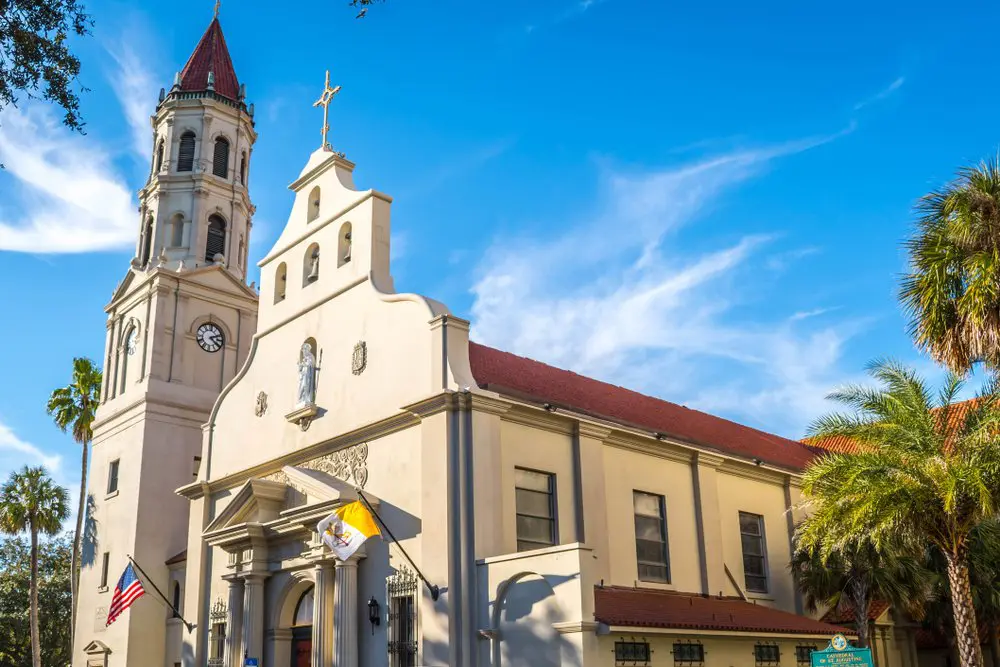The history of St. Augustine dates back to September 1565, when the city was first founded, becoming one of the oldest established cities in the country. Earning its nickname, ‘The Ancient City, St Augustine, is renowned for its stunning architecture and the intricately designed facades that punctuate the cobblestone streets of this remarkable city. Undoubtedly, the jewel in St. Augustine’s crown is the Cathedral Basilica of St. Augustine, the site where the city was first founded and the oldest Catholic Church in the entire state of Florida.
When you explore the history of St. Augustine, you will inevitably find yourself drawn to the Cathedral Basilica of St. Augustine. The construction of this magnificent structure began in 1565, just hours after the formal founding of the city. The Cathedral Basilica of St. Augustine has gone through trials and tribulations over the years due to several different influences. These include natural erosion, damage from the ocean, human destruction, and other factors that have impacted its preservation and structure. However, nowadays, the Cathedral Basilica of St. Augustine stands proudly on its original site, inspiring countless people to visit St. Augustine to explore the fascinating history of this beautiful structure.
Continue reading to learn more about the Cathedral Basilica of St. Augustine.
The Founding Of The Cathedral Basilica of St. Augustine
To understand the history of the Cathedral Basilica of St. Augustine, let’s first go back in time before construction began. In 1565, Spanish explorer Don Pedro Menéndez de Avilés set sail from Spain destined for the New World. On the feast day of St. Augustine, Menéndez de Avilés and his time sighted Florida’s east coast. Consequently, they named the settlement in honor of San Augustín. After making landfall on September 8th, they held a mass in celebration of the founding of the new settlement, which led to the establishment of the Cathedral Basilica of St. Augustine. Despite having little or no construction experience, the crew managed to construct the first church here using whatever materials they could find nearby. The result was a simple structure that served as the initial church on the site.
A Series of Fires Impact The Church
In 1585, a war broke out between the English and the Spanish. During this conflict, Englishman Sir Francis Drake sailed across the Atlantic with the intention of seizing control of St. Augustine, which was then under the control of the Spanish empire. During the city’s capture, the region was pillaged; and the city, along with its church, was burned to the ground. Although the citizens were quick to rebuild, they constructed the new church of straw and palmetto, which didn’t hold up to Florida’s hot climate. Soon, another fire destroyed the church for a second time.
St. Augustine Is Without A Church For Ninety Years
The citizens built a new third church, this time using timber, as they believed it to be a stronger and more durable material. However, without adequate maintenance, the structure soon went into disrepair. A combination of a lack of upkeep and the harsh weather conditions led to the church’s demise. Additionally, the growing number of people using the church added to the strain on the building. In 1702, the British governor of colonial South Carolina, James Moore, invaded St. Augustine, destroying the church in the process. Despite many failed attempts to rebuild over the following years, and even with a large investment from the King Of Spain in 1707, St Augustine remained without a church for more than ninety years.
The Return Of The Spanish Reignites Religious Beliefs
When the English arrived, Catholicism began to slowly decline. It wasn’t until the arrival of a new workforce in 1767, comprising primarily of Italians, Greeks, and Minorcans, that the religion started to witness a revival. In 1786, two years after the English relinquished control of St. Augustine to the Spanish, the Spanish crown requested the construction of a new church. Construction of the new Spanish Mission-style church began in 1973 and took four years to complete.
Status Raised To ‘Cathedral’ In 1870
In 1870, a new Catholic diocese was created, which elevated the status of the church to Cathedral. A fire damaged the Cathedral again in 1887, but they had the potential to save the interior. Following the fire, they launched a national appeal to raise funds for rebuilding the interior of the church. They subsequently hired New York architect James Renwick Jr. to initiate the reconstruction project. The project expanded the cathedral’s overall size, featuring an exposed timber ceiling and a bell tower with four bells. Notably, one of those bells was salvaged from the earlier St. Augustine church and is believed to be the oldest bell in the entire United States.
In 1976, Pope Paul IV raised the status of the church once again to a minor basilica after they added the Blessed Sacrament Chapel in a renovation ten years prior. The Cathedral Basilica of St. Augustine earned the distinction of being the 27th church to receive this prestigious honor.
Visit The Cathedral Basilica of St. Augustine
No visit to St. Augustine would be complete without a trip to the city’s most famous church. A visit to the Cathedral Basilica of St. Augustine can be a great way to explore the history of St. Augustine and learn more about the events and people that shape the region today. Take the time to discover more about this fascinating building and the role it played in history and gain a new perspective and appreciation for the Cathedral Basilica of St. Augustine.
